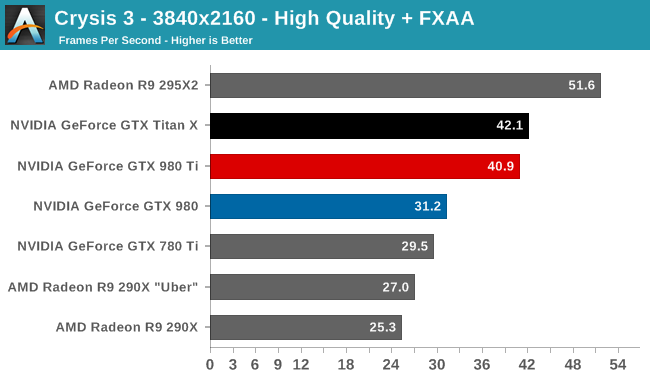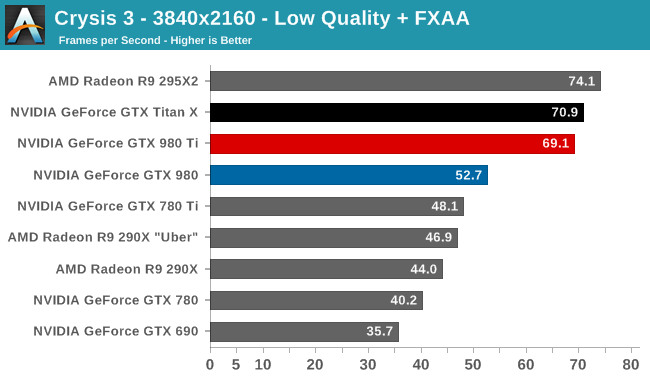The NVIDIA GeForce GTX 980 Ti Review
by Ryan Smith on May 31, 2015 6:00 PM ESTCrysis 3
Still one of our most punishing benchmarks, Crysis 3 needs no introduction. With Crysis 3, Crytek has gone back to trying to kill computers and still holds “most punishing shooter” title in our benchmark suite. Only in a handful of setups can we even run Crysis 3 at its highest (Very High) settings, and that’s still without AA. Crysis 1 was an excellent template for the kind of performance required to drive games for the next few years, and Crysis 3 looks to be much the same for 2015.



Once more we find the GTX 980 Ti and GTX Titan X virtually tied. Across all settings and resolutions the GTX 980 Ti stays within 97-98% of the Titan’s performance. Consequently GTX Titan X is ever so marginally better, but not enough to make any real difference.
This also means that GTX 980 Ti continues with its very strong lead over the GTX 980. Once more we’re looking at a 26-31% performance advantage for the latest member of the GTX 900 series, in-line with its price premium.
Meanwhile on an absolute basis, as one of our most punishing games this is also a good reminder of why even GM200 cards can’t quite pull off high quality 4K gaming with a single GPU today. Even without MSAA and one step below Crysis 3’s Very High quality settings, the GTX 980 Ti can only muster 40.9fps. If you want to get to 60fps you will need to drop to Low quality, or drop the resolution to 1440p. The latter will get you 83.2fps at the same quality settings, which again highlights GTX 980 Ti’s second strength as a good card for driving high refresh rate 1440p displays.










290 Comments
View All Comments
xenol - Monday, June 1, 2015 - link
Transistor count means nothing. The GTX 780 Ti has 2.8 billion transistors. The GTX 980 has around 2 billion transistors, and yet the GTX 980 can dance with the GTX 780 Ti in performance.As the saying goes... it's not the size that matters, only how you use it.
Niabureth - Monday, June 1, 2015 - link
Don't want to sound like a messer schmitt but thats 2,8K cuda cores for GK110, and 2K for the GM204. The GK110 has 7.1 billion transistors.jman9295 - Tuesday, June 2, 2015 - link
In this very article they list the transistor count of those two cards in a giant graph. The 980 has 5.2 billion transistors and the 780ti 7.1 billion. Still, your point is the same, they got more performance out of less transistors on the same manufacturing node. All 28nm means is how small the gap is between identical components, in this case the CUDA cores. Each Maxwell CUDA is clearly more efficient than each Kepler. Also helping is the double VRAM size which probably allowed them to also double the ROP count which greatly improved transistor efficiency and performance.Mithan - Sunday, May 31, 2015 - link
It matters because we are close to .16/20nm GPU's, which will destroy these.dragonsqrrl - Sunday, May 31, 2015 - link
"we are close to .16/20nm GPU's"People said the same thing when the 750Ti launched. I'll give give you one thing, we are closer than we were, but we are not "close".
Kevin G - Monday, June 1, 2015 - link
The difference now is that there are actually 20 nm products on the market today, just none of them are GPUs. It seems that without FinFET, 20 nm looks to be optimal only for mobile.felicityc - Tuesday, January 11, 2022 - link
What if I told you we are on 8nm now?LemmingOverlord - Monday, June 1, 2015 - link
@SirMaster - The reason people care about the process node is because that right now - in mid-2015 - this is an extremely mature (ie: old but well-rehearsed) manufacturing process, which has gone through several iterations and can now yield much better results (literally) than the original 28nm process. This means that it's much cheaper to produce because there are less defective parts per wafer (ie: higher yield). Hence ComputerGuy2006 saying what he said.Contrary to what other people say "smaller nm" does NOT imply higher performance. Basically when a shrink comes along you can expect manufacturers to do 1 of two things:
a) higher transistor count in a similar die size, with similar power characteristics when compared to its ancestor - and therefore higher performance
b) same transistor count in a much smaller die size, therefore better thermals/power characteristics
Neither of these factor in architectural enhancements (which sometimes are not that transparent, due to their immaturity).
So ComputerGuy2006 is absolutely right. Nvidia will make a killing on a very mature process which costs them a below-average amount of money to manufacture.
In this case Nvidia is using "defective" Titan X chips to manufacture 980 Ti. Simple as that. Their Titan X leftovers sell for $350 less and you still get almost all the performance a Titan would give you.
royalcrown - Wednesday, June 3, 2015 - link
I take issue with point b) " same transistor count in a much smaller die size, therefore better thermals/power characteristics"I disagree because the same die shrink can also cause a rise in power density, therefore WORSE characteristics (especially thermals).
Gasaraki88 - Monday, June 1, 2015 - link
Smaller nm, bigger e-peen.